The living room is the soul of your home, and its importance is felt even more during the holiday season. It’s where families gather to exchange gifts, where friends toast to the new year, and where memories are made that last a lifetime. Christmas decorations can transform an ordinary living space into something magical—a reflection of joy, warmth, and celebration.
Whether you’re working with a spacious area or looking for living room small space designs that’ll bring you joy, this guide covers everything from traditional elegance to modern minimalism. I’ve put together 21 stunning Christmas decor ideas that’ll help you turn your living room into a festive haven this holiday seaso. Let’s dive in!
Traditional Christmas Living Room Magic
Traditional Christmas decor evokes nostalgia and comfort—it’s like a warm hug on a cold winter evening. These timeless approaches never go out of style and can be refreshed year after year.
1. Classic Color Combinations That Never Fail

There’s a good reason why red, green, and gold dominate the Christmas color spectrum—these colors create a psychological response of warmth, nature, and celebration. Red stimulates excitement and passion, green represents life and renewal, while gold adds a touch of luxury and celebration.
“Colors aren’t just decorative elements—they’re emotional triggers that set the tone for your entire holiday experience,” explains interior designer Maria Johnson. “The traditional Christmas palette works because it balances stimulation with comfort.”
When implementing this classic palette, remember that balance is eveything. Too much red can feel overwhelming, while too little might not capture the festive spirit. Try this approach:
- Use red as an accent color through cushions, throws, and key ornaments
- Incorporate green through natural elements like garlands, wreaths, and the Christmas tree
- Add gold touches through ribbons, candle holders, and tree toppers
Sometimes, its the small details that make the biggest impact. A red velvet bow on a green wreath or gold-rimmed glassware on the coffee table can tie everything together beautifully.
2. Timeless Ornaments with Family History
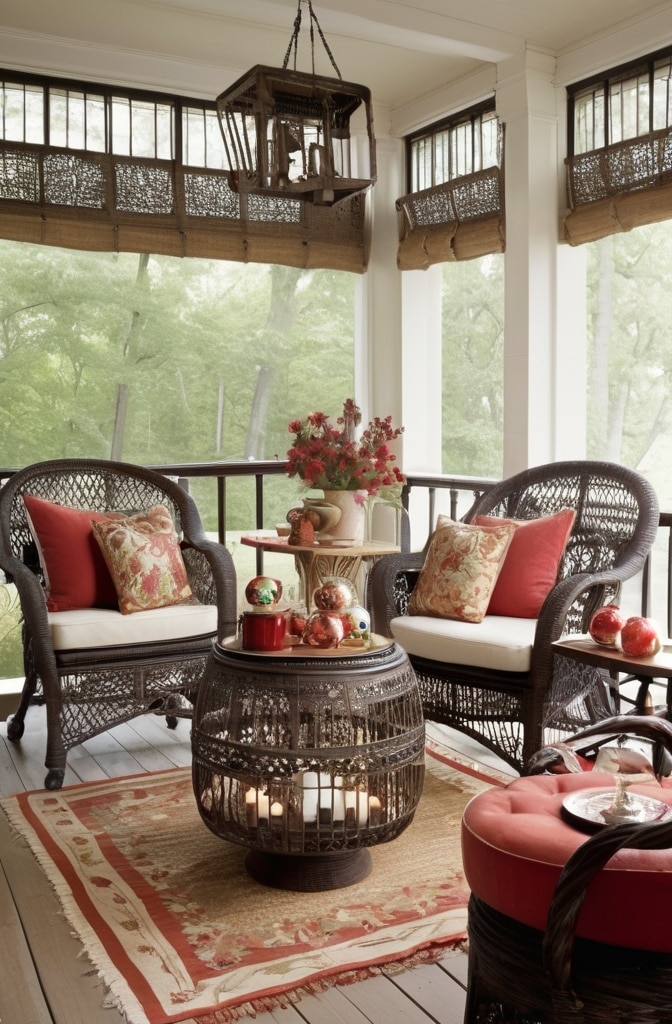
Nothing creates a sense of continuity and tradition like family heirlooms displayed during the holidays. According to a survey by the American Christmas Tree Association, families who incorporate heirloom ornaments report 40% higher satisfaction with their overall holiday decor.
“Family ornaments carry stories—they’re not just decorations but vessels of memory,” says holiday historian Sarah Meadows. “When you unwrap that ornament your grandmother gave you, you’re unwrapping a piece of your family story.”
To highlight these special pieces:
- Create a dedicated “heritage” section on your tree for family heirlooms
- Display particularly special ornaments in glass cloches or on mantlepieces where they can be better appreciated
- Start new traditions by purchasing a special ornament each year that represents a significant family moment
Don’t worry if you don’t have generations of ornaments—starting your own collection is just as meaningful. Consider creating personalized ornaments featuring family photos or hand-painted designs that can become tomorrow’s treasures.
Modern Approaches to Festive Decor
For those who prefer contemporary aesthetics, modern Christmas decor offers clean lines, unexpected color combinations, and a fresh take on holiday traditions.
3. Minimalist Christmas Styling That Impresses
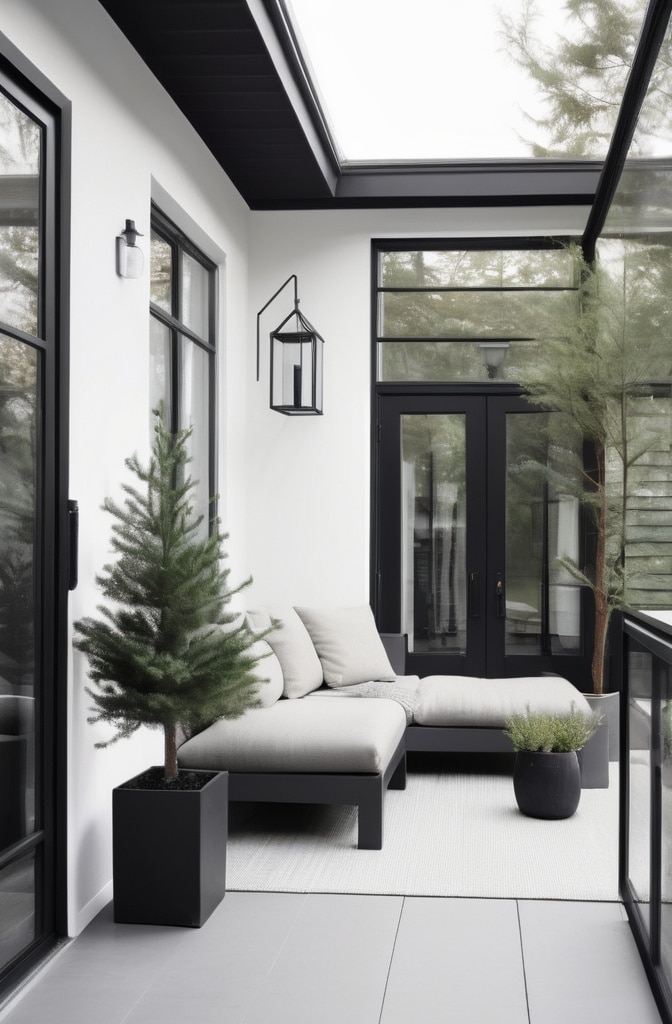
Minimalism isn’t about deprivation—it’s about intention. A minimalist Christmas focuses on quality over quantity, allowing each carefully chosen element to shine.
The “one statement piece” approach works particulary well in smaller spaces. Rather than scattered decorations, invest in a single spectacular item—perhaps an architecturally interesting tree, a stunning oversized wreath, or a dramatic lighting installation.
When working with a white and silver palette:
- Choose varying shades of white (ivory, cream, snow white) to create depth
- Add texture through materials like frosted glass, brushed metal, and natural fibers
- Incorporate small touches of greenery to warm up the cooler tones
Research from Home & Garden magazine found that minimalist holiday decor increases perceived spaciousness by up to 30%—perfect for urban apartments or smaller living rooms.
4. Contemporary Metallic Accents That Elevate
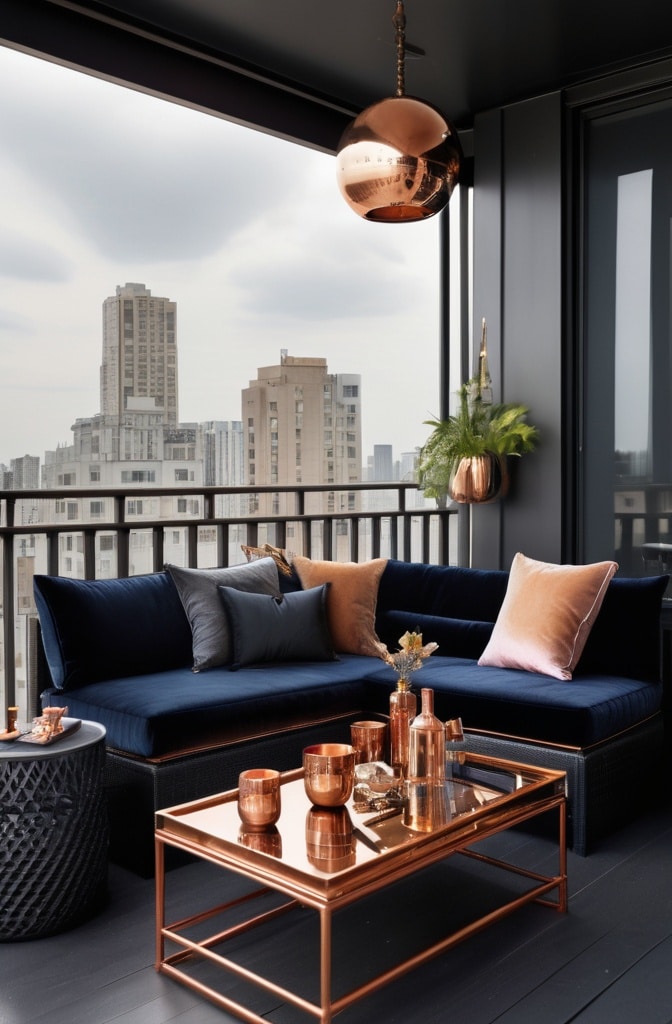
While gold has traditionally dominated holiday decor, contemporary approaches embrace a wider metallic spectrum. Rose gold adds warmth, copper brings rustic sophistication, and mixed metals create visual interest.
For maximum impact, strategic placement is key:
- Cluster metallic objects in groups of three at varying heights
- Place metallics near light sources where they’ll reflect and amplify brightness
- Balance shine with matte textures to prevent visual overload
Interior stylist Thomas Reed suggests: “Think beyond ornaments—metallic thread woven through a garland, metallic-dipped feathers in a vase, or a copper wire string light display can be subtle yet striking.”
When working with metallics, lighting is everything. The soft glow of candles or warm LED lights will enhance metallic finishes, while harsh overhead lighting can make them appear cheap or overwhelming.
Creating Cozy Christmas Atmospheres
The Danish concept of “hygge” (pronounced hoo-ga)—creating a warm atmosphere of comfort and contentment—is perfectly aligned with Christmas decorating goals. Here’s how to achieve ultimate coziness.
5. Layering Textures for Ultimate Comfort
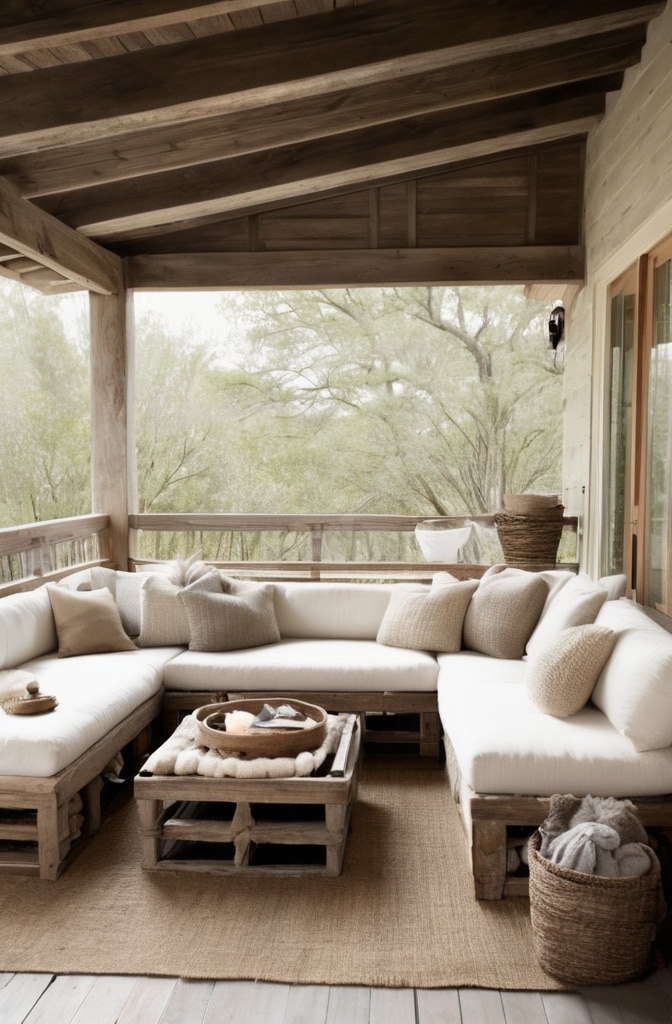
Texture is the secret weapon of interior designers, particulary during winter months when warmth becomes both visually and physically important.
To create a luxuriously cozy living room:
- Start with a base layer of smooth fabrics (cotton, linen)
- Add medium textures (wool, velvet) through throws and cushions
- Top with highly textural elements (faux fur, chunky knits) as accents
- Incorporate natural textures like wood, pine cones, and evergreen branches
“Seasonal textile swaps are the fastest way to transform a room,” says textile designer Elena Gomez. “Replacing lightweight summer cushion covers with velvet or wool versions immediately signals a seasonal shift.”
A 2023 study by Home Psychology Institute found that rooms with at least three distinct texture types were rated as significantly more inviting and comfortable than those with uniform textures—something to keep in mind as you plan your holiday haven.
6. Ambient Lighting Secrets
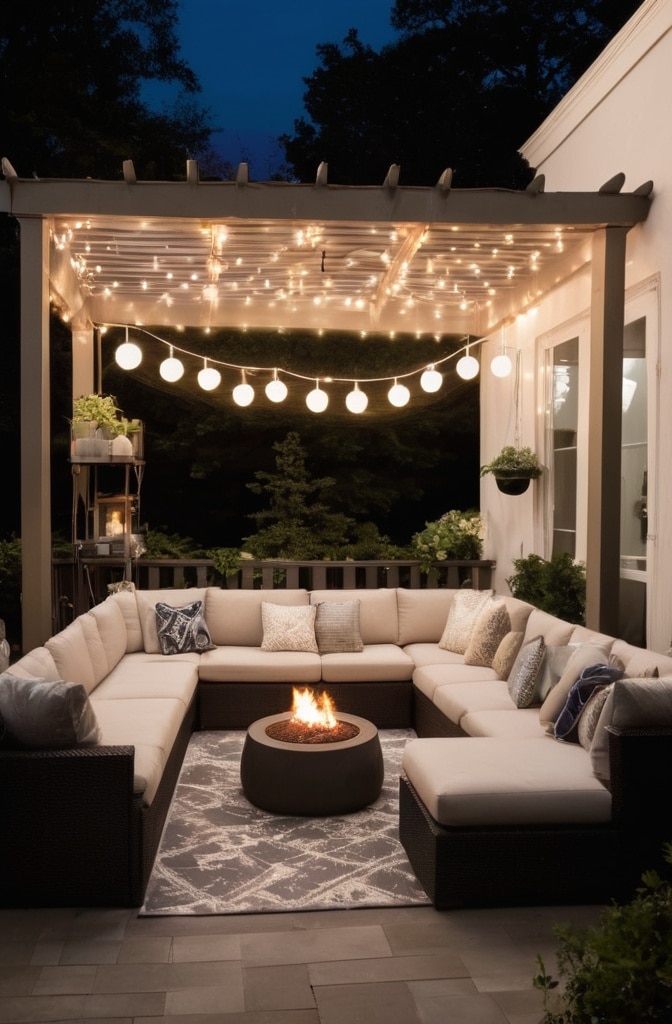
Lighting creates atmosphere like no other element, and during the darkest days of the year, it becomes even more crucial.
Beyond traditional fairy lights, consider:
- Twinkle lights in glass jars or lanterns
- Rope lights tucked behind furniture for a subtle glow
- Projector lights that cast gentle patterns on walls or ceilings
- Flameless candles in areas where safety is a concern
For candle arrangements, the rule of odd numbers creates visual appeal. Group 3, 5, or 7 candles of varying heights on a mirrored or metallic tray for maximun impact.
Smart lighting has revolutionized holiday decorating. Systems like Philips Hue or LIFX allow you to program color changes, dimming schedules, and even synchronize lights to holiday music—an impressive feature when entertaining guests.
“The ideal holiday lighting plan includes at least three light sources at different heights in each room,” recommends lighting designer James Peterson. “This creates a layered effect that feels both sophisticated and welcoming.”
Themed Living Room Transformations
A cohesive theme can elevate your Christmas decor from pleasant to professional. Here are two perennially popular approaches that offer distinctive aesthetics.
Read This Blog: https://hometranquil.com/red-christmas-living-room-ideas/
7. Scandinavian-Inspired Winter Wonderland
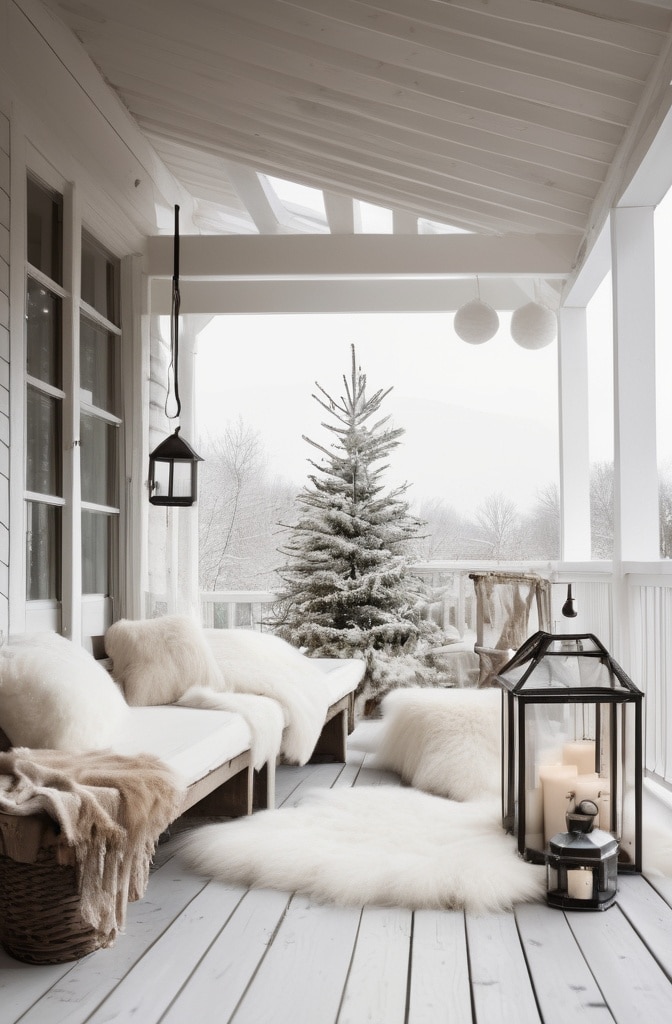
Scandinavian design principles—simplicity, functionality, connection to nature—translate beautifully to holiday decor. The Nordic approach emphasizes light during dark winters, creating spaces that feel bright and uplifting.
Key elements of Scandinavian Christmas decor include:
- A restricted palette of white, cream, gray, and natural wood
- Simple geometric forms and clean lines
- Natural materials like wood, paper, straw, and wool
- Abundant candlelight (Danes use more candles per capita than any other European country)
To create stunning light and shadow play:
- Use paper star lanterns hung at different heights
- Place candles in front of reflective surfaces
- Incorporate items with cut-out patterns that cast interesting shadows
- Add fairy lights inside clear glass containers
“What makes Scandinavian design so appealing is its honesty,” explains Nordic design expert Lars Nilsson. “It doesn’t try to be something it’s not—it embraces winter’s darkness by creating islands of light and warmth.”
8. Rustic Farmhouse Christmas Charm
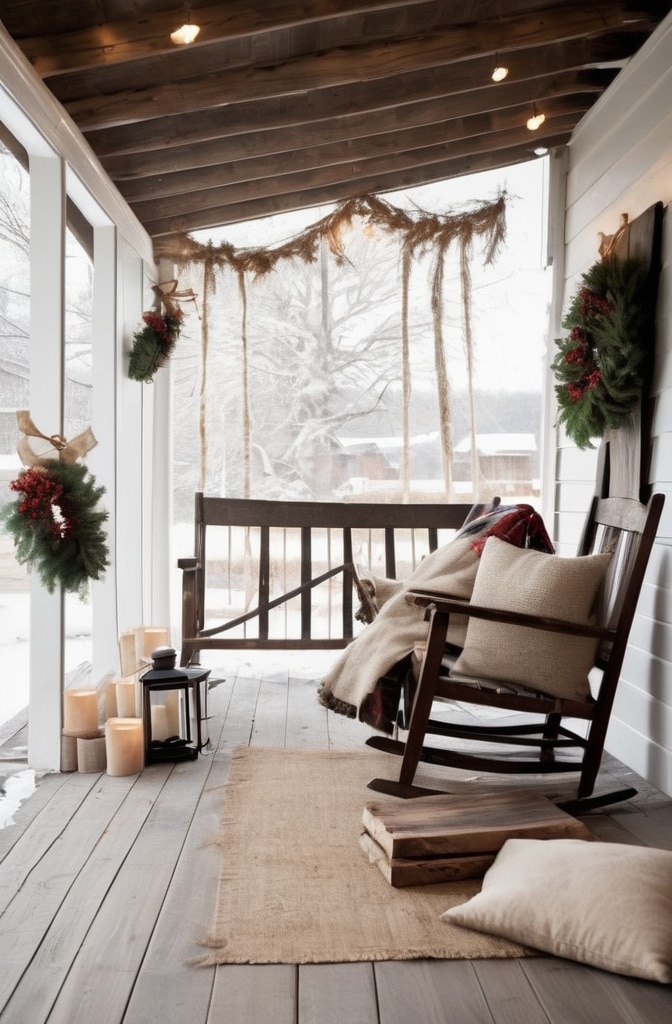
Farmhouse style continues to captivate with its blend of practicality, comfort, and nostalgia. During Christmas, this aesthetic really shines with opportunities to showcase natural elements and handcrafted touches.
To bring rustic charm to your living room:
- Use galvanized metal containers for greenery or wooden crates as display platforms
- Incorporate buffalo check patterns through textiles
- Display collections of vintage ornaments in wooden bowls or dough bowls
- Add handmade paper ornaments or popcorn garlands for an old-fashioned touch
For a showstopping DIY centerpiece, try this designer trick: fill a wooden toolbox or vintage container with assorted pinecones, cinnamon sticks, dried orange slices, and sprigs of evergreen. Add battery-operated lights woven throughout for evening ambiance.
“What makes farmhouse style so enduring is its emphasis on gathering,” says country living expert Joanna Miller. “These aren’t showpiece rooms—they’re designed for families to actually use and enjoy.”
Color Scheme Deep Dives
Color sets the emotional tone for your holiday decor. Let’s explore three distinctive approaches that create dramatically different atmospheres.
9. Red & Gold: Creating Luxurious Warmth
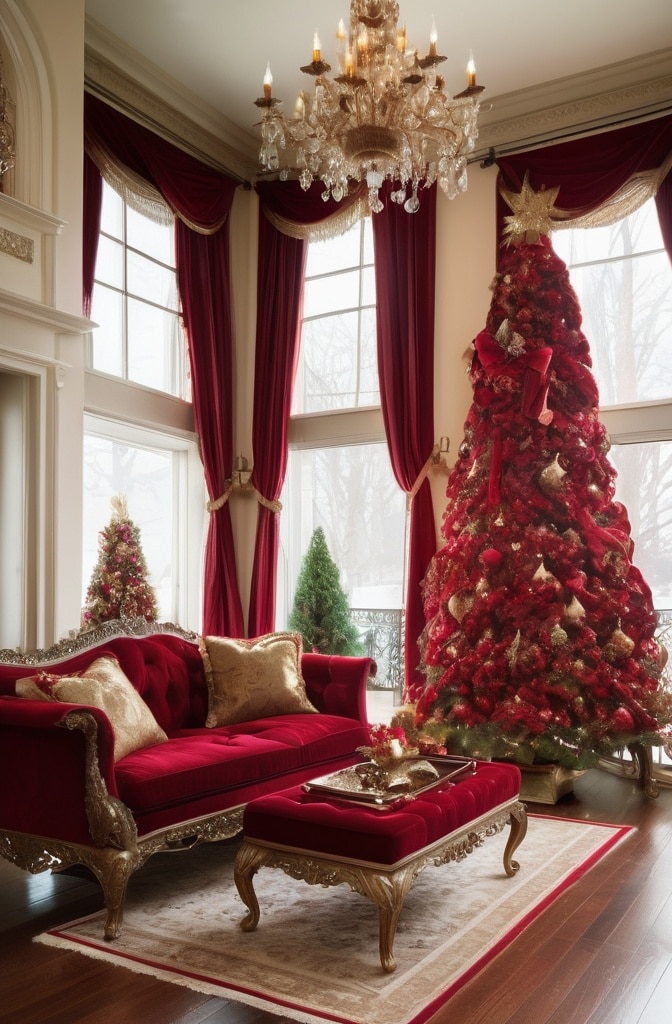
Red and gold is perhaps the most classically festive combination, evoking opulence and tradition. But within this palette lies considerable variety—from deeper burgundies to brighter cranberry reds, from antique gold to bright brass tones.
For a sophisticated approach:
- Choose a dominant red (either berry-toned or deeper crimson) and stick with it
- Complement with both bright and antique gold finishes
- Add small touches of cream or ivory to prevent heaviness
- Consider incorporating small amounts of dark green for depth
“The secret to working with strong colors like red is knowing when to pull back,” advises color specialist Marcus Rivera. “Let some surfaces breathe without decoration to highlight your color statements more effectively.”
Try this designer trick: place gold candle holders of varying heights on a red velvet table runner with scattered evergreen sprigs and pinecones for a centerpiece that’s both classic and fresh.
10. Serene Green & White Environments
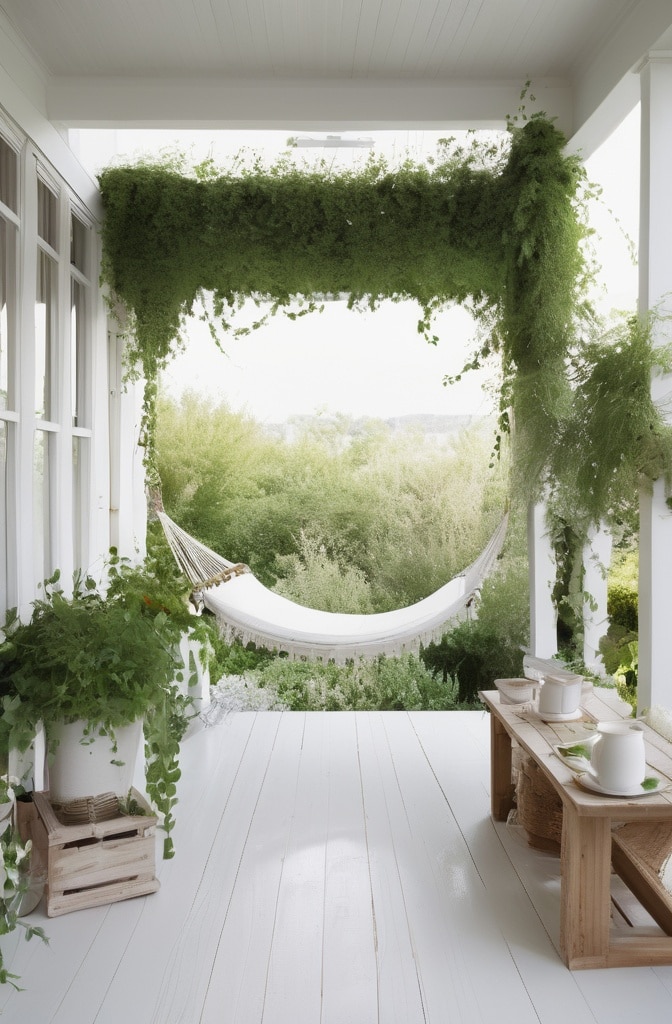
For a fresher, lighter approach to holiday decorating, green and white creates a peaceful yet festive atmosphere that references the natural world.
To create visual “snow effects”:
- Use flocked greenery that appears dusted with snow
- Incorporate white berry sprigs throughout arrangements
- Add elements with pearl or iridescent finishes that suggest ice and frost
- Use white faux fur elements that mimic snowdrifts
Incorporate different shades of green—from silvery sage to deep forest—to add depth to your scheme. This creates a more sophisticated look than flat, single-tone greenery.
Living plants that thrive in winter can augment your decor while improving air quality:
- Paperwhite narcissus (which can be forced to bloom indoors)
- Rosemary topiaries (which release a wonderful fragrance when touched)
- Small potted cyprus trees
- Christmas cactus with its timely blooms
“Green and white schemes work so well because they feel clean and bring nature indoors during months when we’re often disconnected from it,” explains botanist and designer Dr. Emma Chang.
11. Sophisticated Black & White With a Twist
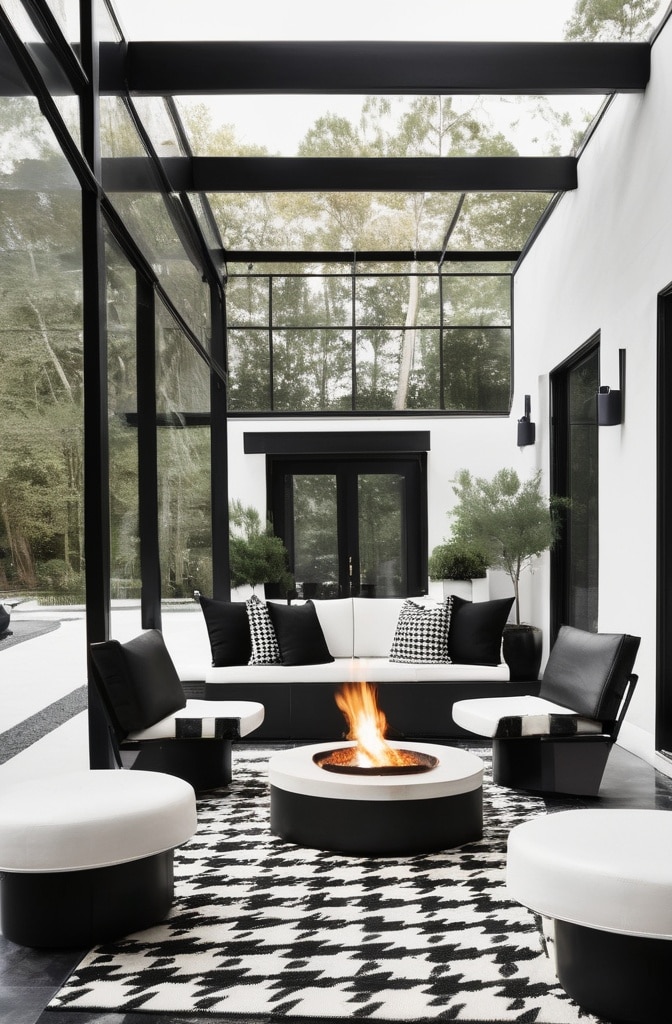
For the design-forward decorator, black and white offers an unexpected and striking holiday palette. This monochromatic approach feels modern and allows architectural elements and textures to take center stage.
To prevent this scheme from feeling flat:
- Incorporate one unexpected pop of color—perhaps burgundy, emerald, or even hot pink
- Play with patterns like houndstooth, stripes, or damask
- Mix matte and glossy finishes for visual interest
- Layer multiple textures to add warmth and dimension
In limited color schemes, texture becomes even more important. Consider:
- Chunky black and white knit stockings
- Glossy ceramic ornaments alongside matte paper ones
- White faux fur tree skirts with black ribbon trim
- Black velvet ribbons on white matte-finished wreaths
“The sophistication of black and white comes from its inherent contrast,” says design psychologist Nathan Brooks. “Our brains are naturally drawn to this level of distinction, which is why it feels both dramatic and satisfying.”
Small Space Solutions
Limited square footage shouldn’t limit your holiday spirit. Smart decorating strategies can maximize impact while minimizing crowding.
12. Vertical Decorating Techniques

When floor space is at a premium, look up! Vertical decorating maximizes your decorative impact without sacrificing functional space.
Wall-mounted alternatives to traditional trees include:
- A tree-shaped arrangement of string lights secured with removable hooks
- A wooden or metal tree-shaped wall hanging that can hold small ornaments
- A flat fabric tree that attaches to the wall with velcro
- A series of floating shelves arranged in a triangular pattern, decorated with small ornaments and greenery
According to small-space design specialist Mei Lin, “Ceiling space is the most overlooked decorating opportunity in small homes.” Consider hanging:
- Paper snowflakes or stars at varying heights
- Lightweight ornaments from ribbon attached to the ceiling
- Evergreen boughs or garlands along ceiling beams or crown molding
- A “chandelier” of fairy lights cascading from a central point
These vertical elements naturally draw the eye upward, creating the illusion of more space while adding festive touches.
13. Multi-Purpose Decorative Elements
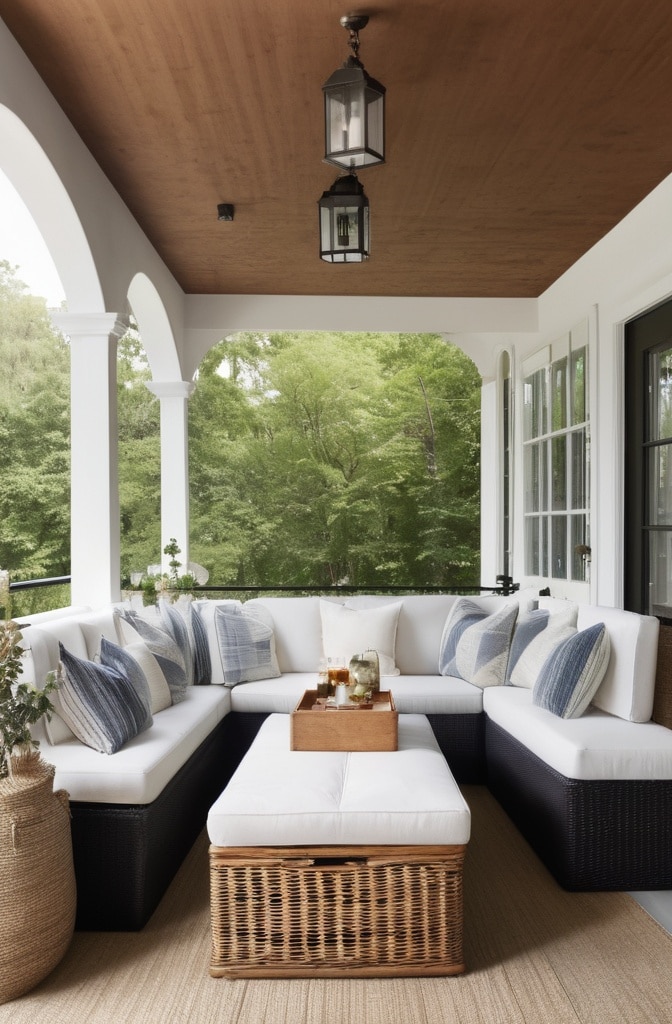
In small spaces, every item should earn its keep—ideally serving both functional and decorative purposes.
Consider these dual-purpose ideas:
- Gift-wrapped empty boxes that serve as both decoration and side tables
- Decorative baskets that store extra throws while adding texture
- Scented pine cones that fragrance the room while looking festive
- LED candles that provide both decoration and additional lighting
“Space-saving doesn’t mean sacrifice,” emphasizes small space expert Tamar Lawrence. “It means being more intentional and creative with what you choose to include.”
One particularly clever trick from professional stagers: replace your usual artwork with holiday-themed pieces for the season. This adds festive elements without taking up any additional space in your room.
Budget-Friendly Brilliance
Creating a designer-worthy holiday display needn’t break the bank. Strategic investments combined with creative DIY can yield spectacular results.
14. Upcycled Decorations With Designer Appeal
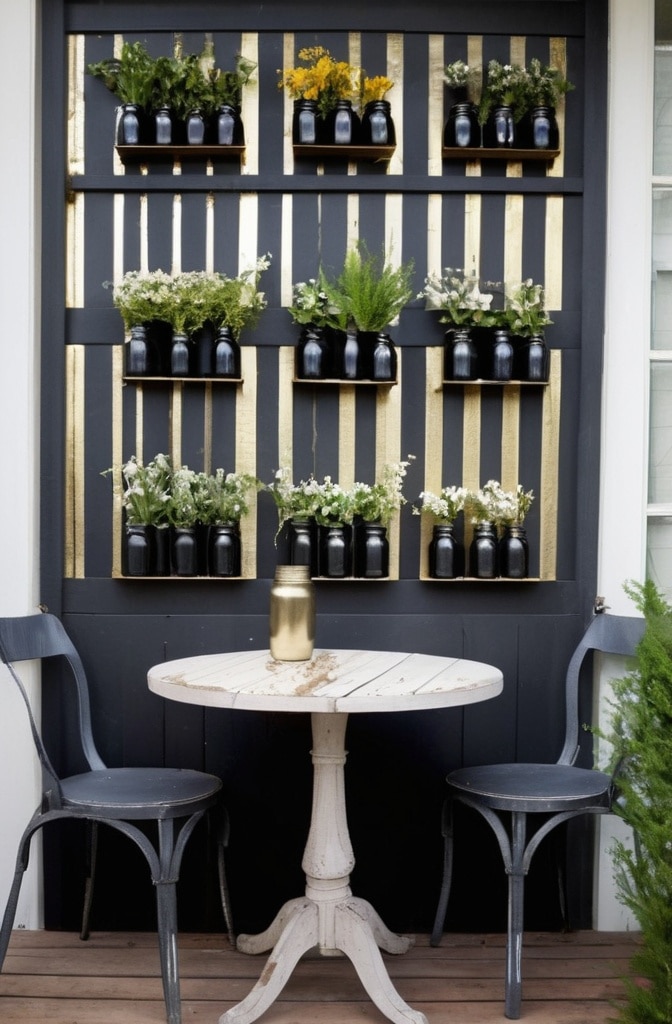
Some of the most charming and unique holiday decorations come from repurposing everyday items with creative vision.
Items worth transforming include:
- Old sweaters cut and sewn into pillow covers or stockings
- Vintage teacups filled with small ornaments or votive candles
- Mason jars turned into snow globes or luminaries
- Wine corks assembled into wreaths or tree ornaments
For a signature DIY project that looks high-end: gather pinecones from your neighborhood (free!), lightly spray the tips with white paint for a “frosted” look, add a touch of fine glitter while still wet, and arrange in a thrift-store silver bowl for a designer-worthy centerpiece that costs under $10.
Thrift stores can be treasure troves for holiday decorating. Look for:
- Crystal or silver candlesticks (don’t worry about tarnish—it adds character)
- Vintage ornaments, especially Shiny Brite or similar glass styles
- Old picture frames that can be painted and used to frame holiday scenes
- Brass animal figurines that can be incorporated into tablescapes
“The most interesting homes mix high and low, old and new,” says stylist Rebecca Torres. “Upcycled items often become conversation pieces because they’re unique and have a story.”
15. Low-Cost, High-Impact Focal Points
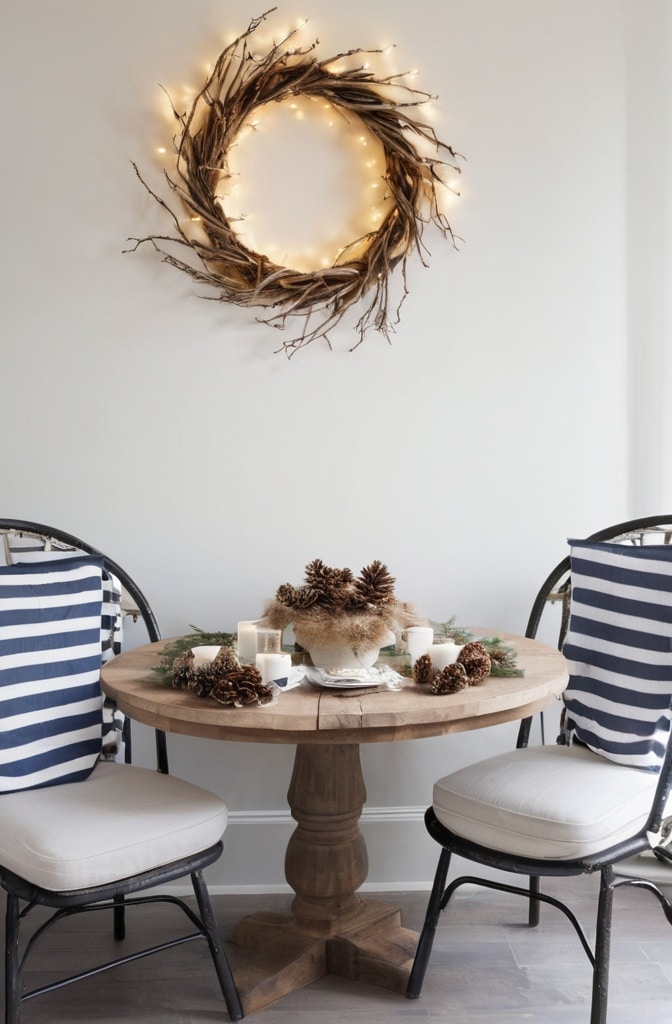
Some decorative elements deliver disproportionate visual impact relative to their cost. These are worth focusing on for budget decorating.
For window treatments that transform rooms:
- Paper snowflakes (sophisticated versions made with high-quality paper)
- Fairy lights arranged in curtain formation
- Simple greenery hung from tension rods
- Ornaments suspended at varying heights on clear fishing line
To create dramatic entrances affordably:
- Wrap a plain doorway with an evergreen garland enhanced with ribbon
- Create an ornament “curtain” by hanging shatterproof ornaments on ribbon
- Frame doorways with battery-operated string lights
- Add greenery and pinecones to an existing mirror or picture frame
“The strategic use of ribbon is possibly the biggest budget-friendly secret in holiday decorating,” reveals event designer Carlos Mena. “A high-quality wired ribbon can be shaped into bows, woven through greenery, wrapped around plain ornaments, or draped across mantels—all for minimal cost.”
Natural Elements & Sustainability
As environmental awareness grows, many decorators are embracing sustainable approaches that celebrate nature’s beauty while preserving it.
16. Bringing the Outdoors In: Beyond the Tree
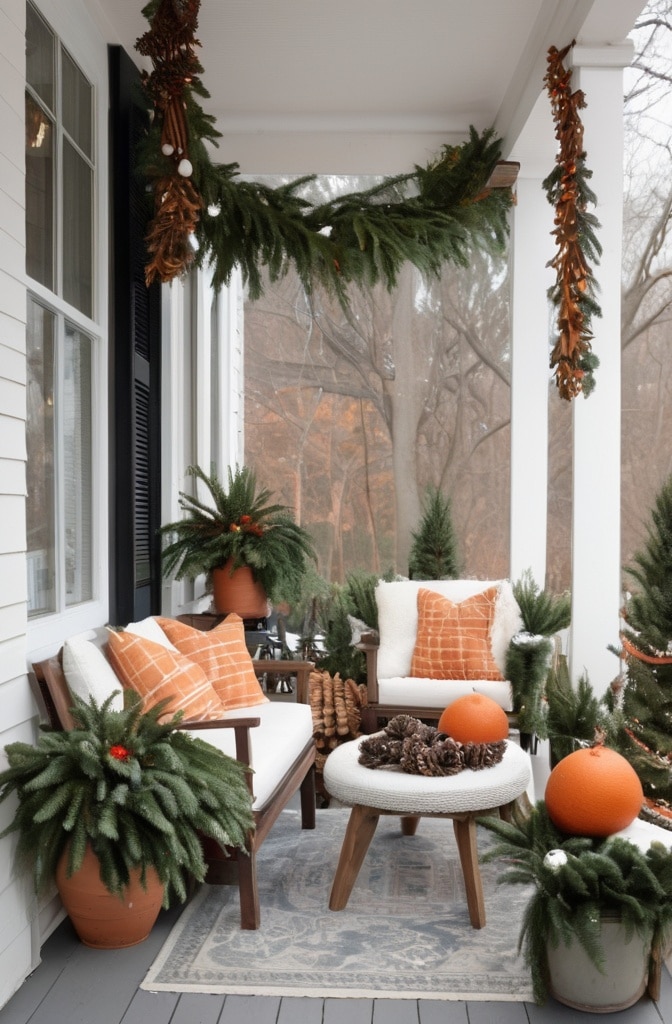
Natural elements add authenticity and connection to holiday decor. Winter provides a surprising abundance of decorative materials if you know where to look.
A quick foraging guide:
- Pine boughs: Parks often trim trees and may allow you to take cuttings (always ask first)
- Pinecones: Gather after dry weather for easier cleaning
- Holly: Look for bushes with berries in public spaces where trimming is permitted
- Birch branches: These add sculptural elements to arrangements
To preserve natural finds for longer display:
- Soak pinecones in a solution of 1 part white glue to 3 parts water, then allow to dry completely
- Dip holly or other berries in clear floor wax for a protective coating
- Spray evergreen branches with anti-transpirant products like Wilt-Pruf
- Keep arrangements away from heat sources that accelerate drying
“Natural elements ground our holiday experience in the reality of the season,” says environmental psychologist Dr. Jarrett Palmer. “They remind us of our connection to the natural world even as we celebrate indoors.”
For a creative centerpiece, fill a wooden dough bowl with water and float cranberries, pine sprigs, and floating candles—an arrangement that can be composted after the holidays.
17. Eco-Friendly Alternatives to Traditional Decor
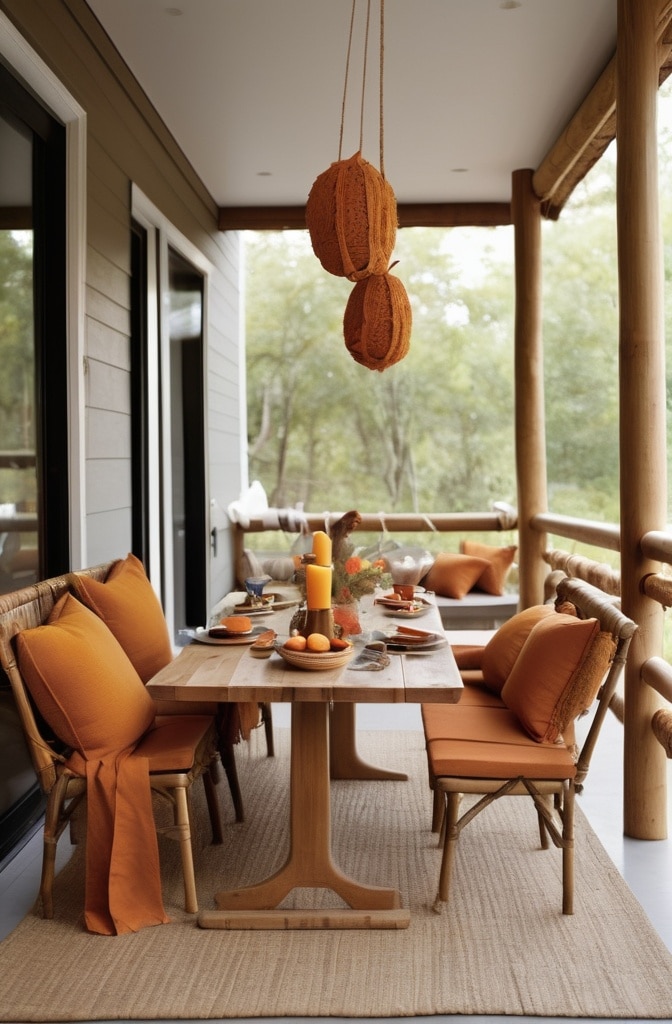
Sustainable decorating isn’t just good for the planet—it often results in more unique and meaningful displays.
Consider these earth-friendly swaps:
- Fabric gift wrap (furoshiki style) instead of paper
- LED lights instead of incandescent (using 75% less energy)
- Ornaments made from natural materials like wood, felt, and sea shells
- Popcorn or cranberry garlands instead of plastic ones
To reduce holiday waste while maintaining style:
- Invest in higher-quality items meant to last for decades
- Choose decorations that can be composted or recycled
- Opt for plastic-free packaging when purchasing new items
- Consider rental services for special items used only occasionally
Biodegradable decor options gaining popularity include:
- Beeswax candles instead of paraffin
- Salt dough ornaments painted with natural pigments
- Dried orange slice garlands
- Cinnamon stick bundles tied with twine
“The most sustainable decoration is the one you already own,” reminds environmental designer Eliza Greenwood. “Before buying anything new, shop your home for items that could work in fresh ways.”
Style-Specific Approaches
Different decorative styles evoke different emotional responses. Whether you’re drawn to the charm of bygone eras or the sophistication of contemporary design, there’s a holiday expression that aligns with your personal aesthetic.
18. Vintage Christmas Revival

Vintage-inspired Christmas decor taps into collective nostalgia, creating spaces that feel both familiar and special. The key is knowing which elements to highlight from each era.
For identifying authentic vintage pieces worth investing in:
- 1940s-50s: Look for Shiny Brite ornaments with their distinctive colors and shapes
- 1960s: Aluminum trees and color wheels represent mid-century modern holiday style
- 1970s: Ceramic Christmas trees with plastic “lights” have become collector’s items
- 1980s: Oversized colored lights and wooden painted ornaments define this era
When mixing eras, establish a unifying element—perhaps a color scheme or material—that ties disparate pieces together. For instance, a collection of ornaments from different decades can be unified when displayed together on a white tree.
“Creating vintage charm with modern materials is about understanding the essence of each era,” explains vintage collector Maya Winters. “The 1950s were about post-war optimism and bright colors, while the 1970s embraced natural materials and earthier tones. Capture that essence rather than striving for perfect historical accuracy.”
19. Elegant Holiday Transformations
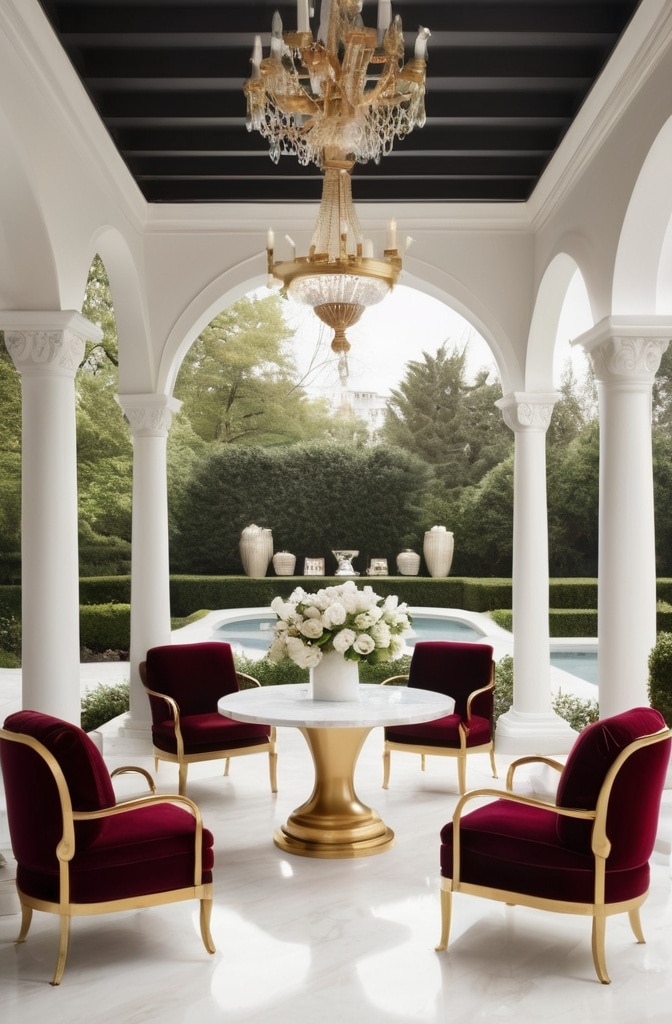
For those special occasions when you want your home to feel truly elevated, sophisticated holiday decor creates a memorable impression.
To create tablescapes that double as decor:
- Layer textiles—placemats, runners, and napkins—in complementary fabrics
- Use unexpected container like julep cups or antique silver pieces for small floral arrangements
- Incorporate candles at varying heights for dimension
- Add small wrapped packages as place card holders
Unexpected color combinations for refined spaces might include:
- Navy and gold for a regal feel
- Plum and silver for romantic sophistication
- Forest green and copper for natural elegance
- Ice blue and platinum for contemporary coolness
Beyond traditional poinsettias, consider these seasonal florals:
- White amaryllis for dramatic height
- Hellebore (Christmas rose) for subtle elegance
- Paperwhites for delicate fragrance
- Red anthuriums for modern tropical flair
“Elegant holiday decor isn’t about spending more—it’s about editing more strictly,” advises event planner Sophia Rodriguez. “Choose fewer, more impactful elements rather than many smaller ones.”
Finishing Touches
The final layer of holiday decorating addresses the sometimes overlooked sensory elements that complete the experience.
20. Sensory Considerations: Scent & Sound
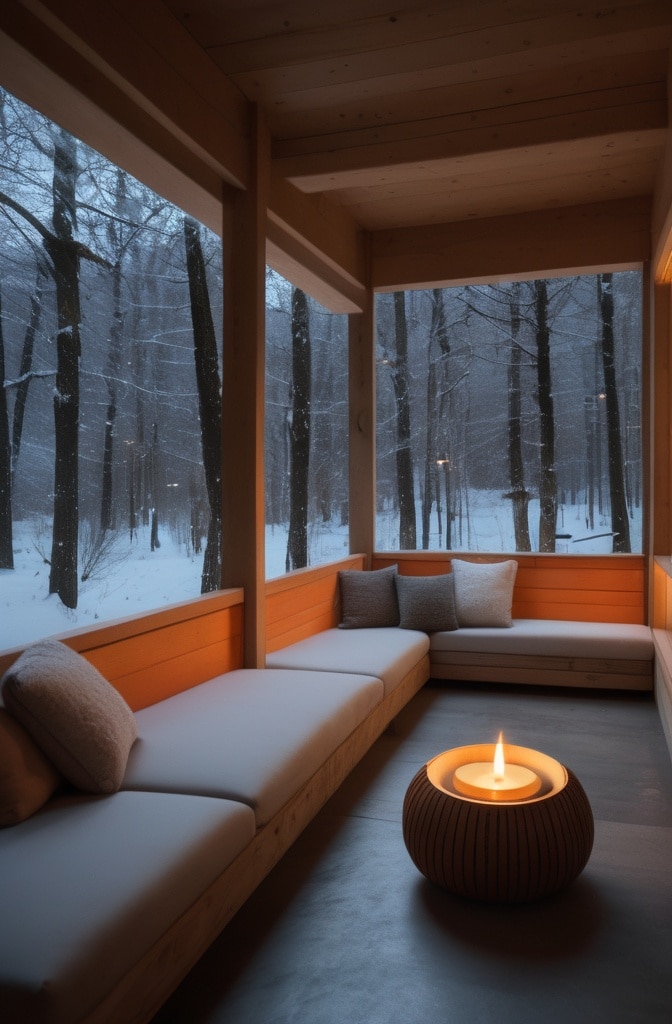
Our olfactory and auditory senses profoundly influence our emotional experience of a space, yet they’re often overlooked in decorating plans.
Natural fragrance options beyond candles include:
- Simmering stovetop potpourri (citrus slices, cinnamon sticks, cloves, and water)
- Pomanders made from oranges studded with cloves
- Evergreen cuttings displayed in water
- Essential oil diffusers with seasonal scents like pine, cinnamon, or vanilla
For subtle holiday sounds:
- Wind-up music boxes placed throughout the room
- Small bells attached to door handles that jingle when used
- A curated playlist of instrumental holiday music at low volume
- The gentle crackle of a real or simulated fireplace
“Our brains process scent directly through the limbic system—the emotional center—which is why fragrance can instantly create a holiday mood,” explains sensory researcher Dr. Anita Singh. “Sound similarly bypasses our rational filters, working on a subconscious level.”
21. Photography-Ready Moments
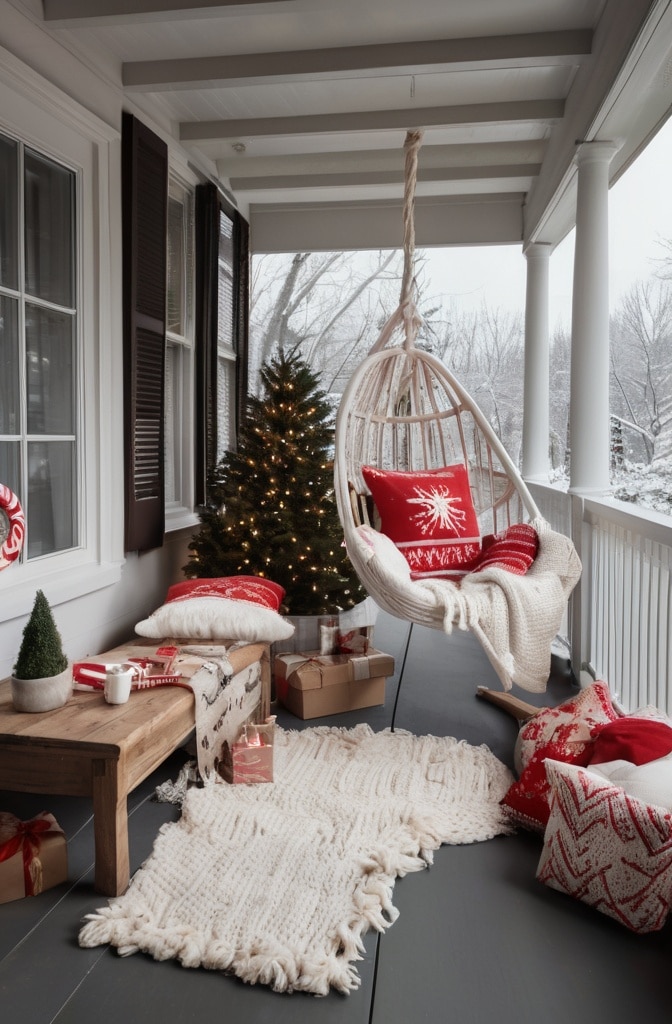
In our social media age, creating spaces that photograph well has become a consideration for many decorators.
For Instagram-worthy corners:
- Create depth with layered decorations rather than flat arrangements
- Ensure adequate lighting from multiple sources
- Include elements at different heights for visual interest
- Add textural contrast (shiny/matte, rough/smooth) that translates well in images
Lighting tips for capturing holiday memories:
- The “golden hour” right before sunset produces warm, flattering light
- String lights can create a bokeh effect (blurred lights in background) in photos
- Avoid overhead lighting which creates unflattering shadows
- Consider reflective surfaces that multiply light effects
For creating backgrounds for family photos:
- Choose a wall or corner with limited visual clutter
- Add a focal point like a wreath or special ornament grouping
- Ensure ample space for family members to stand or sit
- Test your setup by taking sample photos before the gathering
“The most photographed holiday spaces balance festivity with restraint,” notes social media stylist Jackson Lee. “Too much decoration creates visual chaos in images, while too little fails to convey the holiday spirit.”
Conclusion
Transforming your living room for Christmas isn’t just about following trends or traditions—it’s about creating a space that resonates with your personal sense of the season. Whether you’re drawn to minimalist elegance or maximalist coziness, what matters most is that your space feels authentic to you and welcoming to those you share it with.
As you implement these ideas, remember that flexibility is key. Be willing to adapt decorations to suit your actual living patterns. The most beautiful room is one that’s actually enjoyed, not just admired from a distance.
The true magic of holiday decorating lies not in perfection but in presence—creating an environment where memories can be made and traditions both honored and created anew. As you transform your living room this holiday season, may it become a space of comfort, joy, and genuine connection.
Frequently Asked Questions
Q: When is the best time to put up Christmas decorations? A: While traditionally decorations went up after Thanksgiving in the US, many designers now recommend a gradual approach—adding simple elements (like greenery) in early November, and building toward full decoration by early December. This allows you to enjoy the process rather than tackling it all at once.
Q: How can I make artificial greenery look more realistic? A: Professional decorators often “fluff” artificial greenery by bending individual branches in different directions, then interweaving real pine branches or eucalyptus for authentic scent and texture. A light misting of pine-scented room spray can also add authenticity.
Q: My small children/pets make delicate decorations impractical. Any suggestions? A: Focus decoration at higher levels (mantels, tops of bookcases), use shatterproof ornaments, avoid small chokeable items, and consider fabric decorations like felt garlands or stuffed ornaments. Create a designated “touch-friendly” area with unbreakable decorations that children are allowed to handle.
Q: How do I store all these decorations after the holidays? A: Interior organizers recommend photographing your displays before dismantling them, then storing items by room rather than type. Clear bins with detailed labels will save future frustration. Specialized storage (ornament boxes, wreath containers) prevents damage and extends the life of your investment.
